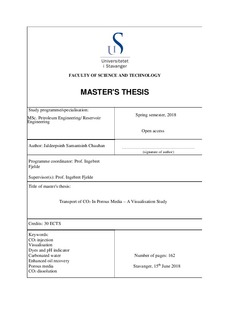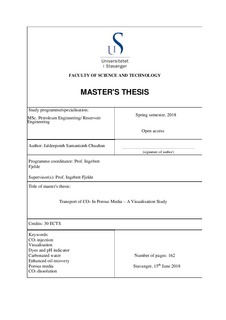| dc.contributor.advisor | Fjelde, Ingebret | |
| dc.contributor.author | Chauhan, Jaldeepsinh | |
| dc.date.accessioned | 2018-10-24T11:49:32Z | |
| dc.date.available | 2018-10-24T11:49:32Z | |
| dc.date.issued | 2018-06-15 | |
| dc.identifier.uri | http://hdl.handle.net/11250/2569332 | |
| dc.description | Master's thesis in Petroleum Engineering | nb_NO |
| dc.description.abstract | The increase in global energy demand coupled with a need to stabilize CO2 emission levels has called for the development of a strategy with the potential to make energy `greener'. One such strategy is Carbon Capture Utilisation and Storage (CCUS). Since its inception, one focus area for laboratory studies has been the visualisation of pore and core scale processes to better understand the underlying mechanisms that govern improved oil recovery and the storage of CO2. Work done in this thesis forms a step-by-step understanding of the fluid system, porous media, and the effect of cell dimensions on the visualisation process and acts as a pre-study towards the use of a transparent 2-D model to investigate convection during transport of CO2 in the porous media.
First, a better understanding of the fluid system was addressed by testing the ability of a pH indicator and different dyes to represent water and oil phases respectively. Static experiments were conducted at ambient conditions by using an analogue fluid to represent the change in pH due to the dissolution of CO2 in water. The visualisation was facilitated using an optical method and the results from these experiments reviewed the performance of dyes and indicator in the oil-water system.
Following this, tests were conducted in graded tubes to determine the ability of dyes/indicator to aid visualisation of imbibition under gravity in a diverse porous media constructed using glass beads of different grain size distribution and wettability. The results from initial tube tests demonstrated a rise in the pH due to a reaction of glass beads with the water phase. Glass beads were treated with an acid to limit the increase in pH, but an alteration in surface properties of glass beads was observed as a result of this treatment. Tube tests were also conducted to examine the effect of varying tube diameter on the movement of water phase in the porous media and the quality of visualisation. Results suggested that the shape of water front invading the porous media was a function of tube diameter and a decrease in diameter facilitated better visualisation but imposed limitations on the ease of operation.
In the next step, experiments were conducted in a glass tube under CO2 injection at 10 bar and 20 C. These tests demonstrated the ability of the pH indicator to help visualise the movement of CO2 in water and also confirmed a possible alteration in surface properties of glass beads due to the acid treatment.
Polycarbonate cells of varying thickness were prepared, and imbibition tests were carried out to study the effect of varying cell thickness on the shape of water front in the porous media and the quality of visualisation. The results using porous media packing showed coherence with experimental studies in the literature conducted using etched glass micromodels. Effect of the decrease in cell thickness showed consistency with results obtained in the tube tests of varying diameter.
Previous experiments helped study fluid system, porous media, and the effect of varying cell dimension on visualisation. These observations were used to conduct tests in a low-pressure cell made using Polyoxymethylene (POM). CO2 injection was facilitated at 10 bar and 20 C, and the experiment conducted in POM cell visually demonstrated the ability of CO2 rich water to improve oil recovery from the porous media after waterflooding. Tests in POM cell established the operational procedure and initial testing of the cell design with the chosen visualisation technique. We welcome further research based on the techniques and the procedures used in this study. | nb_NO |
| dc.language.iso | eng | nb_NO |
| dc.publisher | University of Stavanger, Norway | nb_NO |
| dc.relation.ispartofseries | Masteroppgave/UIS-TN-IEP/2018; | |
| dc.rights | Navngivelse 4.0 Internasjonal | * |
| dc.rights.uri | http://creativecommons.org/licenses/by/4.0/deed.no | * |
| dc.subject | CO2 transport | nb_NO |
| dc.subject | visualisation | nb_NO |
| dc.subject | dyes and pH indicator | nb_NO |
| dc.subject | carbonated water | nb_NO |
| dc.subject | porous media | nb_NO |
| dc.subject | reservoir engineering | nb_NO |
| dc.subject | petroleumsteknologi | nb_NO |
| dc.subject | petroleum technology | nb_NO |
| dc.title | Transport of CO2 In Porous Media – A Visualisation Study | nb_NO |
| dc.type | Master thesis | nb_NO |
| dc.subject.nsi | VDP::Teknologi: 500::Berg‑ og petroleumsfag: 510::Petroleumsteknologi: 512 | nb_NO |


